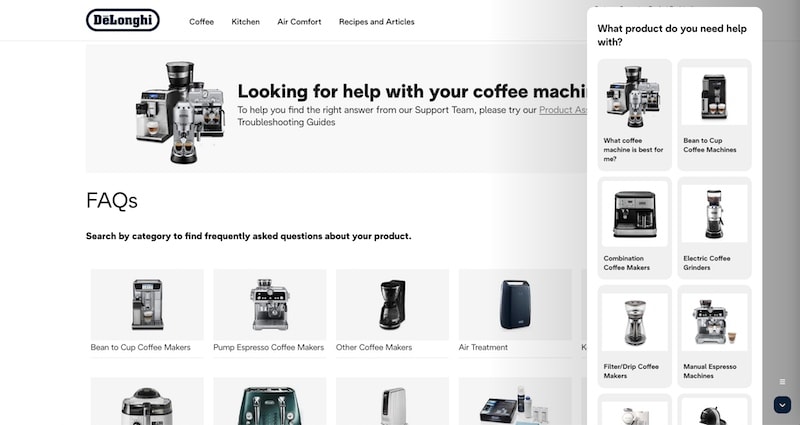How To Make A ChatBot Feel Less Like A ChatBot
If your support team spends a lot of time answering the same questions over and over, could a self-help chatbot tool reduce the load?

Oops! We could not locate your form.
If your support team spends a lot of time answering the same questions over and over, could a self-help chatbot tool reduce the load?

Chatbots and self-help chat tools are increasing in popularity. Personally, I can’t stand them. I prefer to tap through as many options as I can until I am transferred to a human being. This is because most chat tools are set up to be useless and ask pointless questions.
However, recently whilst on the hunt for a fix for my coffee machine, I came across a chat tool that didn’t make me feel like I was using a chatbot.
After recently purchasing a new coffee machine, when it was not even a few weeks old, my wife called me to say that it had red lights flashing and was making a funny noise.
She’d put coffee beans in the grounds compartment and the coffee machine did not like this.
I headed to the Delonghi website to see if there was an easy replacement or fix.
Whilst visiting the support area of the website, the support widget or chatbot, which I’d usually ignore popped up and caught my eye. Why? Because it was visual and showed me the products.

After selecting my machine, I was presented with a range of the most common issues that their support team are contacted about. From descaling and error lights to explanations and brewing issues.
There is also a search box that appears to allow you to type in your problem, which filters as you type. If the suggestions are not helpful, the live chat (human contact) then appears during working hours.
Ultimately, many of the issues users contact Delonghi about are common. If they only provided a standard contact form, their support team would quickly be overwhelmed and overworked answering the same questions over and over again. Or filtering them and sending them to their relevant departments, or using snippet responses to these common issues.
By putting the groundwork in for self-help and making it visual, the user is automatically filtering their request and based on their issues, filtering further until they find their answer.
It’s only then once these common issues and solutions have been exhausted, that the contact form or live chat appears.
This journey, because it was more insightful, was far more pleasant than a standard bot tool.
The chatbot system that Delonghi are using is called Mavenoid. They pride themselves on the ability to create a self-help solution using their tool.

If you’ve previously explored using automated chatbots but felt they were too ‘bot’ like, then take a deeper look at Mavenoid.
Whether product or service support, if your team wastes hours answering the same technical or support-related questions, then a support system like Mavenoid would certainly benefit you, by delivering answers to the most commonly asked questions and allowing your users to self-serve. Only reaching out if they cannot help themselves.
After the initial time investment in setup, a self-help tool can heavily reduce the time spent answering the same questions, and it can inject something visual into the journey to make it feel less like a substandard chatbot.
That’s a wrap for Swipe & Deploy #33. Join me next week when I’ll share another insight or piece of inspiration from around the web.


Whether you are visiting a theme park, zoo or any other type of visitor attraction, there's usually some form of map that customers can download from the attraction's website, that details how they can get around on the day.
 James Coates
James Coates

Whether you're in the 'it's ok to put up your decorations in November' camp or strongly feel that 'December is the date for Christmas decorations', your website is another place that can be decorated with festive touches. If you want to start in November, we won't judge!
 James Coates
James Coates

For publishers and websites that rely on advertisement money to support their commercial income, browser AdBlockers, privacy specialist browsers and rejecting Cookie Consent issues can cause an absolute nightmare.
 James Coates
James Coates